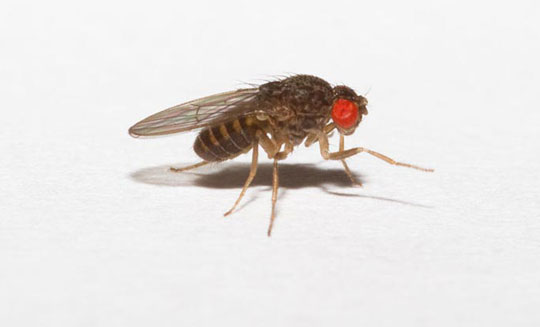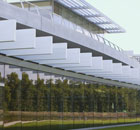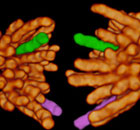
The fruit fly Drosophila melanogaster is a primary vehicle for neuroscientists studying learning and behavior.
The Roots of Memory
You may be prone to getting lost when exploring a new city, but chances are you can get around your hometown with ease. You probably use landmarks—stores, trees, signs—to find the places you frequent. Fruit flies, it turns out, also use remembered landmarks to navigate their surroundings. Understanding how flies store this type of information in the brain could help scientists better understand humans’ so-called spatial memory.
A team of scientists brought together by HHMI’s Janelia Farm Visitor Program designed an experiment to test flies’ ability to remember locations and then found the region in the brain responsible.
On the team were neurobiologist Michael B. Reiser of Janelia Farm and two visiting scientists: HHMI investigator Charles S. Zuker of the Columbia College of Physicians and Surgeons and Tyler Ofstad, an M.D./Ph.D. student at the University of California, San Diego.
The researchers tested whether flies could memorize their surroundings by placing them into small, enclosed, circular arenas. The arena floors were mostly made up of tiles heated to 36 degrees Celsius, slightly above a fly’s comfort level. One tile, however, appeared identical to the rest but was only 25 degrees, a preferable temperature for flies. When a fly entered the arena for the first time, it wandered around until it found the cool spot and then stayed there.
To give the flies cues to remember the cool spot, the researchers patterned the walls of the arena with lines of different angles. The researchers placed groups of flies in the arena for ten practice trials. For each trial the scientists rotated the floors and wall of the arena, keeping them in the same position relative to each other. After training, the flies could find the cool spot in less than 60 seconds, more than twice as fast as it took them the first time.
Even when the researchers removed the cool tile, each fly still made a beeline for where it had been. When the researchers turned off the lights, however, or rotated the floor separately from the marked walls, the flies could no longer locate the cool tile.
Once the scientists had established that the flies could use spatial cues to locate a spot, they wanted to know what part of the brain was involved. They used tools developed by Janelia Farm director Gerald Rubin to switch off neurons in different parts of the brain.
When the researchers turned off neurons in part of the brain called the ellipsoid body, the flies couldn’t better their speed at finding the tile. The findings appeared in the June 9, 2011, issue of Nature.
In future studies, the team hopes to uncover just how the ellipsoid body stores spatial information.



